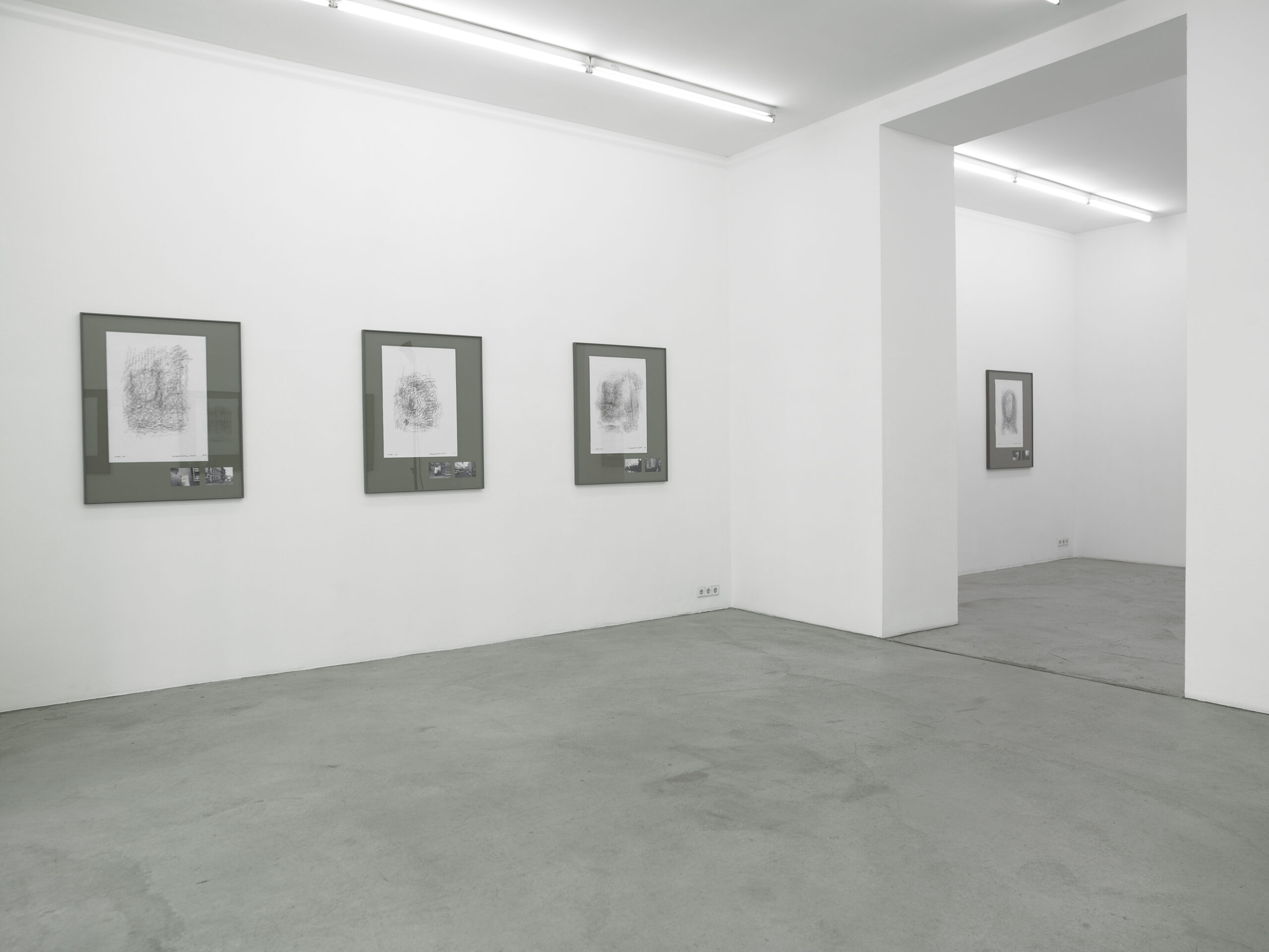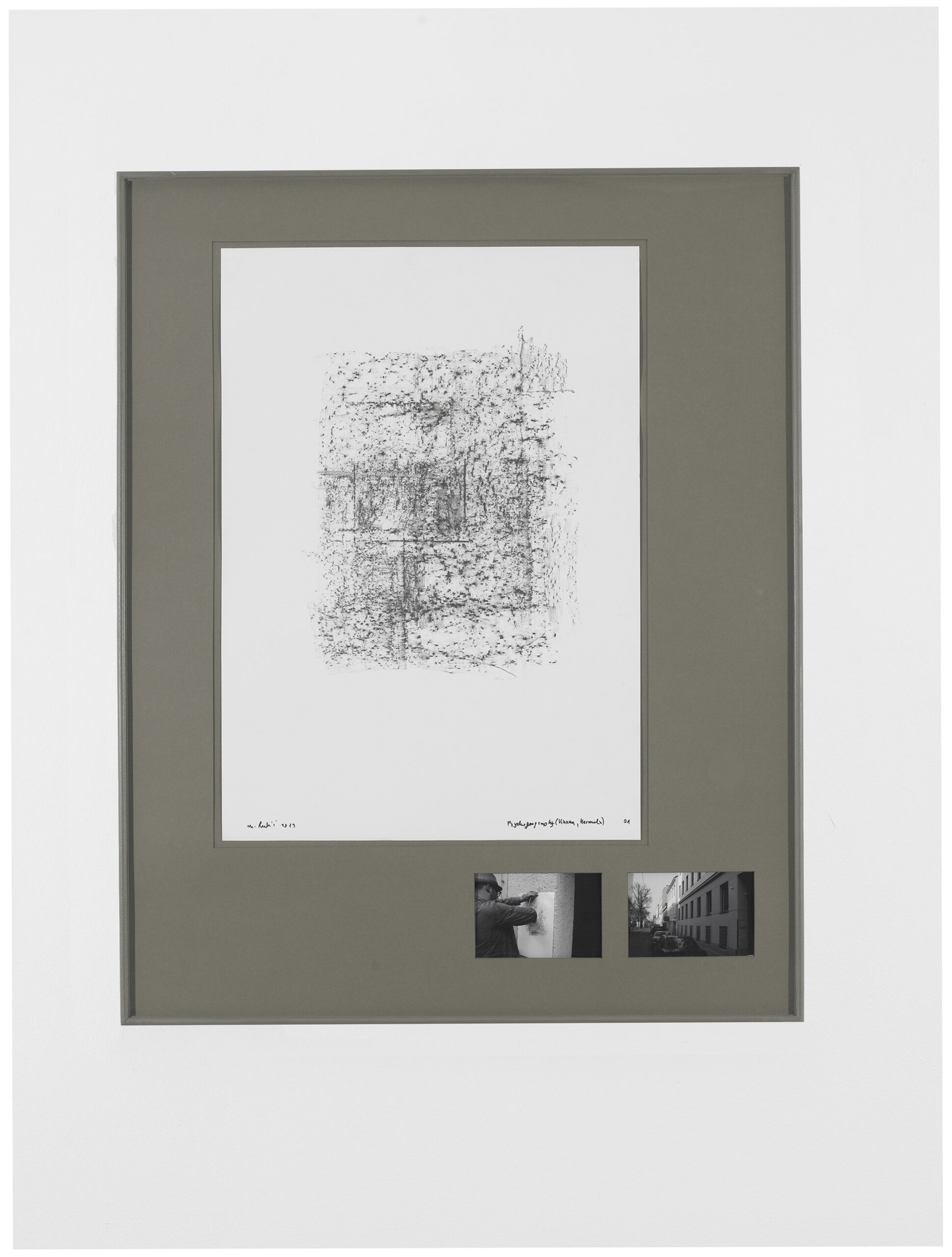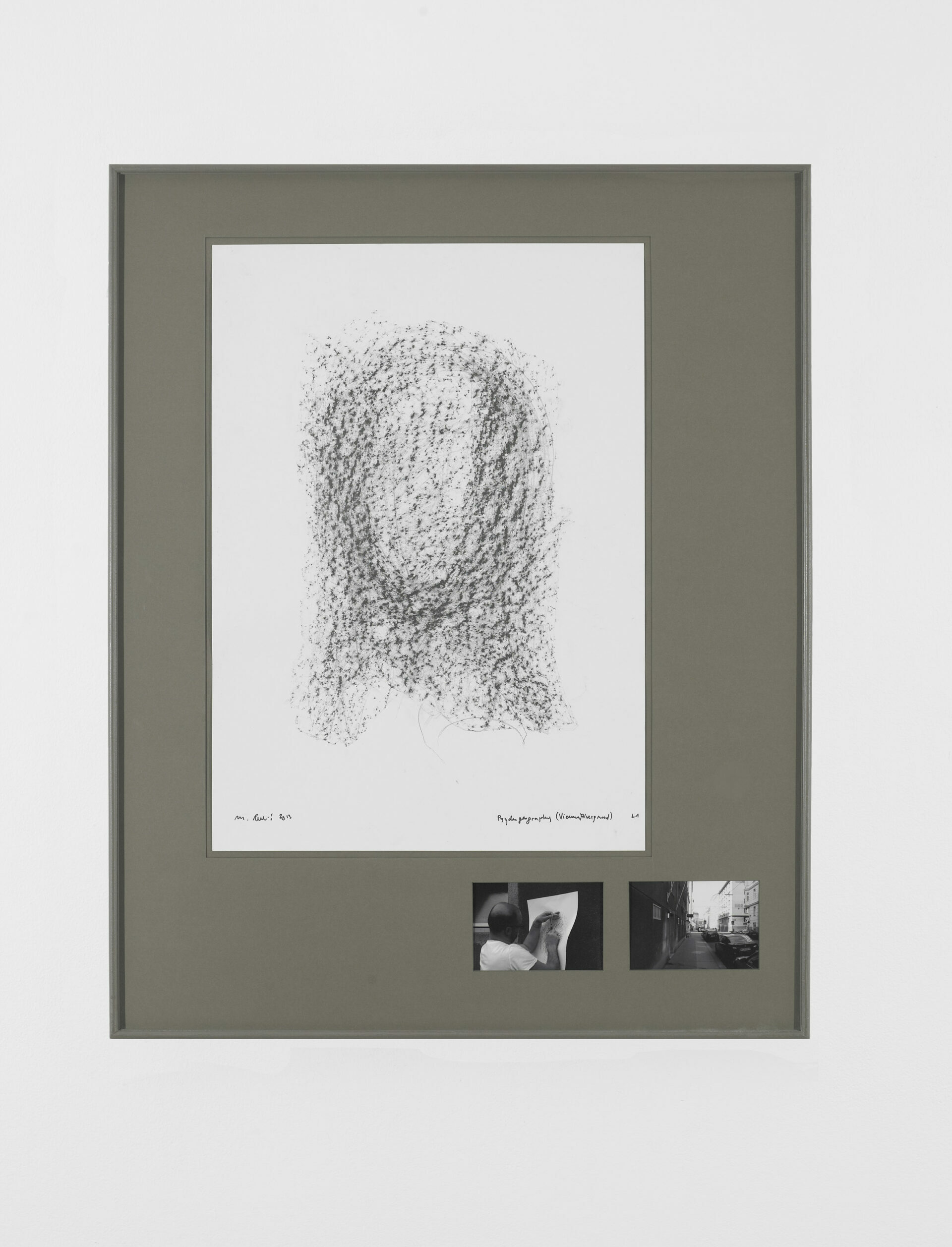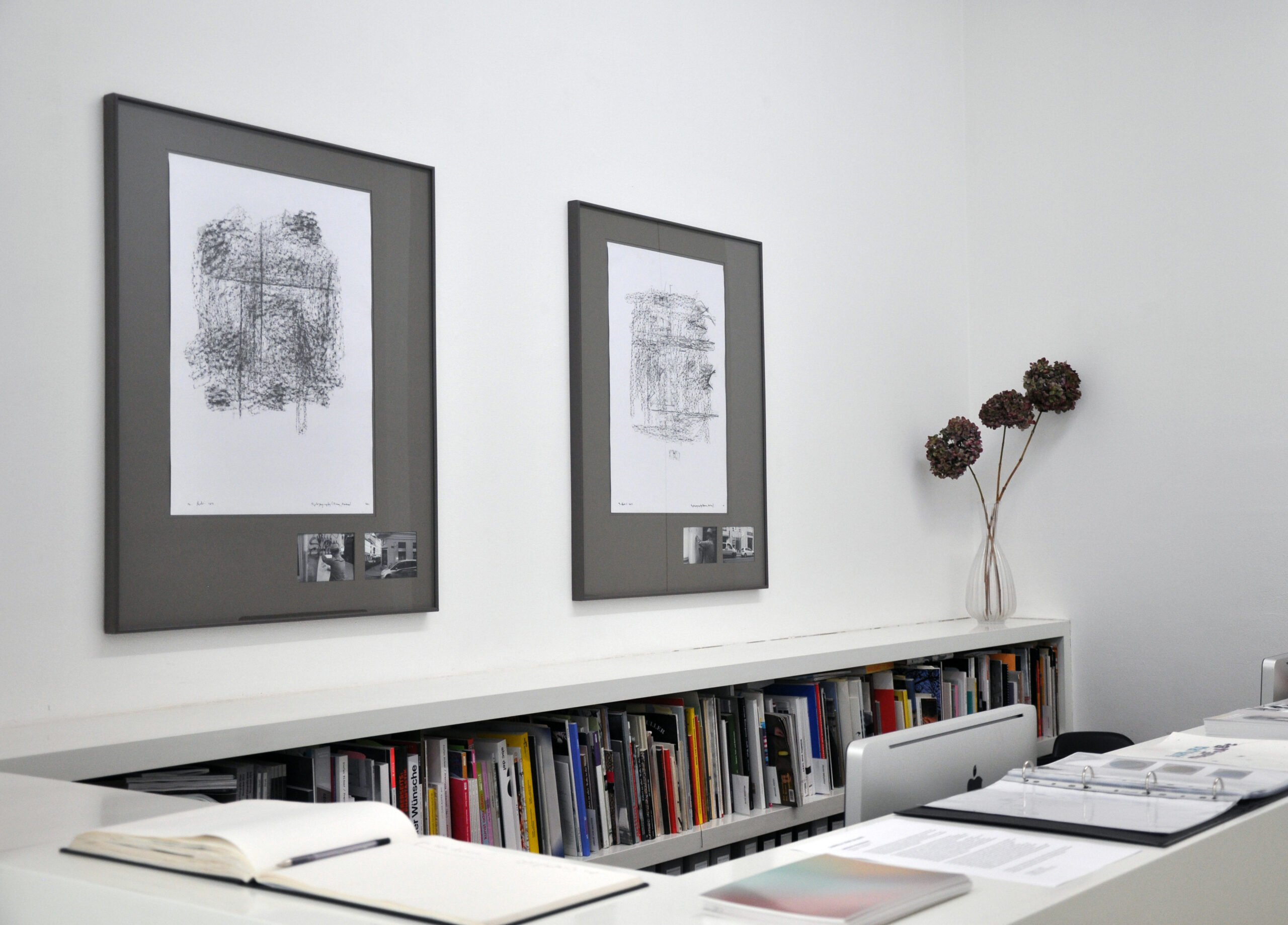
Marko Lulić behandelt in seiner Arbeit eine Vielzahl von Themen und visualisiert diese in verschiedensten Medien. Zu den Kernthemen mit denen sich der Künstler auseinander setzt zählen mit unter auch jene zwei, welche in der aktuellen Ausstellung der Gabriele Senn Galerie sowohl durch Performance als auch durch graphische Elemente verdeutlicht werden – der öffentliche Raum und die Erinnerung.
( Marko Lulic, der in seiner Arbeit eine Vielzahl von Themen behandelt und diese in verschiedensten Medien visualisiert, greift in der aktuellen Ausstellung der Gabriele Senn Galerie zwei seiner Kernthemen, den öffentlichen Raum und die Erinnerung, auf um ihnen sowohl durch Performance als auch durch graphische Elemente Ausdruck zu verleihen)
Lulic, der sich vor allem mit den Bereichen Objekt, Video und Installation beschäftigt, fokussiert stets die tragende Rolle des Körpers in seinem Werk. So ist dieser auch in den aktuellen Arbeiten ein bedeutender Faktor, ebenso das Performative, welches einen wichtigen Bestandteil des Arbeitsprozesses darstellt. In diesem Fall ist es der Gang durch die Stadt, oder vielmehr die Erforschung dieser. Bei Lulics aktuellem Projekt geht es nicht nur um irgendeine Route, sondern um eine sehr persönliche. Es geht um eine Spur der Erinnerung, die in die Gegenwart führt. Der Künstler schreitet seine Biografie ab, die mit dieser Stadt – Wien – verbunden ist, indem er die Wohnhäuser, in denen er im Laufe seines bisherigen Lebens gewohnt hat, aufsucht. Der Prozess geht hier jedoch über das Aufsuchen hinaus und mündet förmlich in einer körperlichen Befragung des Ortes. Die Methode für diesen Akt der Berührung, die Lulic hier wählt, ist eine künstlerische Methode – die Frottage. Eine Technik, die durchaus als aus der Mode gekommen bezeichnet werden kann und der vielleicht sogar der Touch des Verstaubten anhaftet. Doch gerade deshalb wird sie von Lulic hier aufgegriffen, um nicht nur Orte in einer Stadt zu untersucht, sondern auch um eine künstlerische Technik in einen Wiedererkennungsprozess einzubauen, der sowohl der forschenden Frage der eigenen Vergangenheit gerecht wird, als auch der Herangehensweise des Künstlers an diese sehr persönliche Spurensuche./ an dieses sehr persönliche Thema.
Lulic arbeitet derzeit an mehreren sehr unterschiedlichen Projekten, durch die er sich auf unterschiedlichste Weise mit dem öffentlichen Raum Wiens beschäftigt. Die Ausstellung Psychogeography ist das erste von diesen Projekten, das 2013 präsentiert wird.
Der Begriff Psychogeography, auf den sich in der Titel der aktuellen Ausstellung bezieht, wurde von Guy Debord geprägt. Auch wenn der Vorgang, die Stadt zu erkunden, bei Lulic nicht exakt der Methode der Situationisten entspricht, so ähnelt er doch, durch die Betonung des Emotionalen und Individuellen, im Prozess der Kartographierung.
Der Künstler konzentriert sich in der Ausstellung Psychogeography auf die Graphik und thematisiert damit zum ersten Mal in seiner gesamten Ausstellungspraxis diese Technik. Zugleich ist die Graphik – hier die Frottage – eingebettet in ein konzeptuelles Projekt, an dessen Anfang, das Performative steht – in Form eines Spaziergangs. Nicht unbedingt der Flaneur ist es, den Lulic hier als Rolle wählt, sondern eher der Archäologe. Der Archäologe der nicht nur die Schichten der Stadt untersucht, sondern auch die der eigenen Psyche. Hier wäre aber vielleicht auch zu erwähnen, dass Lulic in erster Linie Künstler ist – ein Künstler der mit Rollen spielt und dem die Selbstironie nicht fremd ist.

Marko Lulić
Psychogeography (Vienna, Hernals), 2013
Frottage auf Papier, Fotos
101 x 82 cm (gerahmt)

Marko Lulić
Psychogeography (Vienna, Alsergrund), 2013
Frottage auf Papier, Fotos
101 x 82 cm (gerahmt)
Marko Lulić’s works deal with a wide range of themes which he visualises through various media. Two of his core themes are most certainly public space and the concept of memory, which also play a vital role in his current exhibition at Gabriele Senn Galerie, Psychogeography. The artist combines aspects such as mind, geography and urbanistics, which, ever since the so-called spatial turn, have become a focus of increased research in the context of space, not only in art but also in science.
Lulić, who mostly works with the media object, video and installation, often accentuates the role of the body in his works. Together with the performative element, which constitutes an integral part of the development process, the body theme is also a significant factor in his current works. In the case at hand, it centres on a walk through the city or, rather, the exploration thereof. Lulić’s current project is not only about a random route, but chronicles a very personal way, because it follows a trace of memory, leading up to the present. The artist strolls through his biography which is connected with this city – Vienna – and visits the houses he has lived in so far. The result thereof is a topology nurtured by his memories. But as the process transcends beyond the mere visit and results in a corporal questioning of the space itself, so to speak in an additional level, it thus breaks through the simple memory. As method for this exploration of the room, Lulić has chosen that of an artistic, graphic touch – frottage. This technique is considered to be quite out of fashion these days and has collected a certain layer of dust. But this is exactly why Lulić has picked it here and has integrated it into his performative act. He not only explores the city, but at the same time also looks into the artistic method which he applies in the process. Etymologically, frottage derives from the French term for rubbing “frotter”. The performative and intimate are inherent but the word also contains a certain element of distance – the paper stands between the performer and the object of frottage, in this case that is the wall of a house. The result exhibited at the gallery, i.e. frottage works in combination with photos which document the performance and the space, refers to a topology. However, it shall not be seen as a literary mental map which Lulić intends to present for it is only the observer who can sketch this map him- or herself by finding a relation to the works, thereby breaking through his or her own perception and interpretation. Lulić’s works are no geographic maps, no – they rather constitute documents of his search for evidence – imprints and copies – which together make up the coordinates of a very specific social space.
Lulić is currently working on various different projects through which he deals with public space in Vienna in a quite varied way. The Psychogeography exhibition is the first one of these projects which are to be presented in 2013.
The term psychogeography, to which the current exhibition refers to, was coined by Guy Debord. Even though Lulić’s process of exploring the city does not exactly reflect the situationist method, it still resembles it in its cartography process by highlighting the emotional and individual element.
In Psychogeography, the artist, who in his previous solo exhibitions at Gabriele Senn Galerie mainly drew attention to him by large-scaled objects and installations, now focuses on the selected works which combine frottage and documentary photos. This deliberate and conscious choice of medium also contrasts his prior projects. The graphics – in this case, the frottage – is embedded into a conceptual project whose beginning is marked by the performative – assuming the form of a walk. It is not necessarily the flaneur whose role Lulić choses to assume but rather that of an archaeologist. The archaeologist who does not only explore the layers of the city, but also those of his own mind. At this point, it is also worth mentioning that Lulić shall primarily be seen as an artist – an artist who plays with various roles and who is no stranger to self-mockery.

